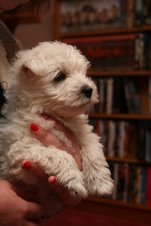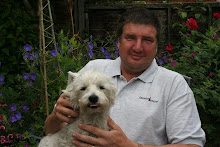 |
| Pretty but disappointingly scent-less, these lily bulbs from Lidl |
I wrote in the last post of our having to hospitalize one of the younger turkeys, struggling with a bloody, cut swelling on the right side of his (her?) head just behind the eye. We think this poor guy had taken a whack from the sparrowhawk before that had been chased away (unsuccessfully, you will have read) by our big male turkey, Tom. Well, the little fella struggled on moopishly through Weds, Thurs and Friday but, although we got some cod liver oil and some water into him he did not eat anything and did not recover. On Saturday he went downhill fast and by 5 pm the kindest thing seemed to be to put him out of his misery. Shame.
 |
One turbine is up. A second, to it's left is still on the ground
in 'kit form' |
On our northern skyline we suddenly have two new features, huge wind turbine towers as part of the new Roosky Windfarm. This impressive title actually only covers the pair of them. The 'farm' is around 3.5 km from here, roughly North. When the huge tall crane appeared I assumed it might be for drilling of water-wells but, no, this windfarm has had planning permission since 2003. It is all on the land of one land owner and he agreed to the farm and takes, I gather, an annual 'compensation' from the power company Gaelectric. The turbines are being assembled and erected by Moriarty.ie, a big civil engineering company.
The websites for Gaelectric and Moriarty are not that up to date but I read that the two turbines plus associated buildings, cabling and power sub-stations etc will cost around €8m, they can put out 4 MW of electricity and supply the power to 1800 homes. The towers are 84 m high and the blade (propellor) diameter is 80 m. With one blade vertical, then, the total height is 124 m or 406 feet. There will also be a meteorological mast on site.
 |
| The second turbine under construction. |
Unless you have been living in a bubble these past few decades, you will know that these things are controversial and there are plenty of folk who are anti, either because they don't like them near their property, or they do not like the visual impact on scenery, or they have concerns about migrating birds and such. I have to say that I am quite supportive of the need for alternative sources of energy (though not nuclear power, till we find out how to dispose of the waste) but I do accept that we are not at the end of a design / improvement road yet.
 |
View from our hilltop with a standard lens - not that much
of an eye-sore! |
Also, I might think differently if these tall structures were our immediate neighbours, of course. We are told that they can be quite noisy when spinning in a good wind and we like our country silence. I have taken a standard-lens shot from our hill top to give you a more realistic view of what we see. Not that much of an eyesore, I think you'll agree. If you look closely at the first pic you might be able to see the many turbines of the bigger Gorteen windfarm "behind" our pair, up on that hill. If the bright sun glints on the spinning blades and white towers and there is a dark sky behind, you can see those distant turbines too. Liz and I both find them quite graceful and elegant in design.
 |
Bob's cattle tuck into some new season silage. The weather
had been so poor for grass growth that they had grazed off
all his non-silage land and he had had to bring this group
indoors to rest the grass. |
Closer to home, I am still assisting JD Bob with his cattle. (Amusing aside warning!). It is definitely "cattle" round here because these are bullocks. The word 'cows' is only applied to the females, so you can ask Bob how his cows are and he will look you straight in the eye anxious to correct your wrong impression of him as a farmer and say "I have no cows, Matt, only these bullocks and a few 'weanlings' "(young calves just off Mum's milk). I am regularly caught out by this 'trap'. Lost in translation. This has been a bit of a run around with different groups of cattle being shifted between loactions while grass fields were rested.
 |
The outdoor group get a couple of cow-with-calf-at-foot
pairs put in with them to try to calm the flighty boys down. |
There was added drama when a couple of more flighty bullocks took off across the fields at a round-up "jumping the fence like a hunter" (said Bob) and spent some time in with Mike-the-Cows's rental grazers (and the bull, Felix). The escapists have now been extracted from that group but not before one of them over-ran his 30 month old limit for top prices at the meat factory in Ballyhaunis. This is not, apparently, the same as the 'mad-cow' age limit in the UK, but the meat factories deduct money for older cattle for quality reasons. At least one of the cattle-men I have spoken to chunters about the factories "just playing games" to diddle the farmer, when they themselves are currently doing very nicely out of the Euro/Sterling exchange rate, thank you.
 |
| White lace cap hydrangea. |
For me this 'work' is nearly done. Bob is getting better each day from his leg injury, most of the cattle from the indoor groups have now been returned to their rested fields and the 'escapists' plus a few more are due to be collected by the meat-factory's cattle-truck in a few days. I will miss them (especially gentle old 274 with his pale-buff limousin colouring and big soft eyes, bless him). I like cattle and I admire these beefy, chunky 2-year olds, plus I like working with them. We do not have the land or infra-structure to 'do' any of the full sized commercial-beef animals ourselves, but we have talked about keeping one or two of the diminutive Dexter variety. Dreams, I guess. May never happen.
 |
| The bee blanket in use this week. |
Even closer to home, Liz has been getting on with the sewing-machine 'evening classes' and has started to branch out from throw cushions and test squares. I commissioned a 'bee blanket', a roughly 18 inch square of dense, opaque material which you drop over the hive frames when you go in to examine the hive, and then peel/roll back frame by frame as you work. This saves having to expose all the bees immediately to daylight (and heat-loss) before you need to - you start at the back frame and it takes a few minutes to examine each, so the last frames can stay snug and dark while you work.
 |
We prefer the white variety of Japanese Anenome, though
these flowers are a bit rain-bashed. |
Liz has also decided to give a try to making actual bee-keeper suits with all the zips and all-enclosing shape that they entail, including the wire hoops stiffening the veil and the mesh visor itself. She has sneaked my suit off to one evening class to get the pattern worked out and has today been measuring me in all directions and has gone in armed with all the special cloth (white 'drill') and bits and pieces. Brave girl.












1 comment:
I have to say I share your views on wind farms - they can be quite graceful! In the Netherlands they tend to paint the columns with "sky colours" - pale blues and greens, and they look lovely. Not sure about the noise if one were to live too close though... though I don't remember them being noisy when we stayed close to some in France.
Post a Comment